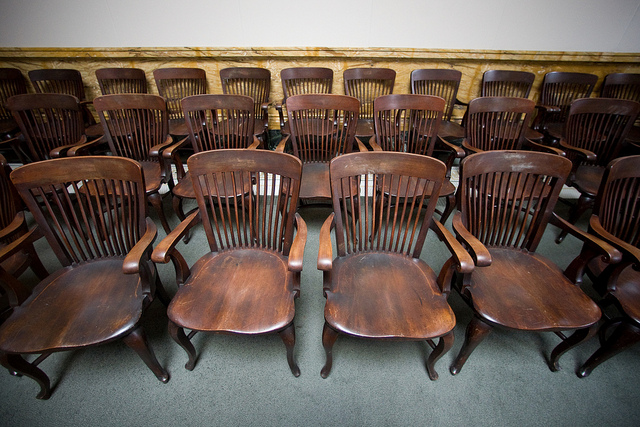Sexual violence and acts of sexual coercion are commonplace. You most likely know someone it’s happened to. Maybe it’s happened to you. Many of these crimes go unreported, and of those that are, many cases never make it to court, or they get thrown out or substantially reduced once they do.
In the national Personal Safety Survey, Australia, 19 per cent of women reported experiencing sexual violence at some time since the age of 15. That’s almost one in five women. Less than one per cent of those are committed by strangers – which means 99 per cent of sexual crimes are committed by someone the victim knows. Many of these happen within a family or an intimate partner relationship. Yet these cases are vastly under-represented in the criminal justice system.
I used to wonder why so few people reported sexual crimes. ‘Don’t you want the offender locked up so they can’t hurt anyone else?’ Is it the trauma of presenting to the police and to court, of retelling the story and being cross-examined? Or is it because it means turning on someone the victim loves, or has loved, with all of the interpersonal connections and complications that might result? Perhaps it’s the shame from the prejudices that still exist in our society, from people who point a finger, deeming the victim somehow complicit in their victimisation? Or do people keep quiet out of fear of retaliation?
If someone had come to me before and told me of a sexual crime, I would have strongly encouraged them to speak up. They should have their crime acknowledged and get the offender’s name on file — if the police don’t get the perpetrator this time, maybe they will the next. That was before I undertook study in forensic sexology.
A closer look at the legal system, and how it is practiced, has shown me that reporting a sexual crime can be an exhausting and traumatic uphill climb. Before a victim sets foot through the police station door, the odds are against them. From there it is one hurdle after another, with the victim facing possible re-victimisation from legal professionals and laymen alike, buttressed by negative attitudes towards victims of sexual crime that are embedded in our culture.
***
When people hold a belief, instead of evaluating new information objectively, they apply a filter that places greater weight on evidence which affirms the belief, while dismissing information which contradicts it. This plays out when a person first presents to the police, and again when they appear in court to face a judge and jury, where the audience will make a snap judgement about them within the first few seconds, forming a belief about the kind of person they are (and later, about the kind of person the offender is).
A person’s appearance contributes greatly to this snap judgement. Do they look like a rapist? Do they look like an innocent? Ethnicity, race, and cultural differences have all been shown to contribute to the evaluation of credibility and believability.
If someone is lucky enough to look innocent and credible, they still face prejudicial beliefs commonly held throughout the criminal justice system. Despite empirical evidence to the contrary (studies have shown less than three per cent of sexual assaults reported are false), experts suggest police officers commonly believe around half of those reporting a sexual crime are lying.
Many involved in the criminal justice system also believe they are able to detect deception with a high degree of accuracy, looking for particular cues to determine whether someone is telling the truth. Studies have found many of these cues to be inaccurate, and that most people, even with specialist training, detect deception in others with about the same accuracy as flipping a coin.
Evidence suggests dismissive attitudes to domestic violence exist throughout the police culture. Seen as a matter between the people involved and not a public concern, reports tend to be poorly documented, with officers assuming the victim will return to the sex offender in a cycle of ongoing abuse, so there is little point pursuing the matter.
Given these prejudicial beliefs, when someone reports a sexual crime, the person taking their statement is likely to follow a line of questioning that seeks to discredit their story, giving more weight to evidence of deception and anything that undermines their story or discredits them as a witness, including seeking inaccurate signs of deception or implying that the victim has a share of responsibility in the crime; that is, victim blaming.
The victim — already fragile and traumatised — can be left feeling invalidated and shamed. They are essentially re-victimised, and risk suffering greater trauma as a result. Unsurprisingly, many withdraw their report at this point.
***
Cases that get beyond this point still might not proceed through the criminal court. To successfully prosecute, police must have sufficient evidence that a crime has been committed, and that the person intended to commit the crime. In cases of ‘date rape’, this can be very difficult to prove. Our social scripts have muddied the way we communicate consent and what many consider ‘acceptable’ behaviour in the pursuit of sex. The evidence often comes down to one word against another.
This plays out in the criminal justice system with the onus on the victim to make their lack of consent known to the offender, rather than on the offender to prove they obtained unambiguous consent. The judge and jury must be convinced beyond reasonable doubt that the offender knew they did not have consent and committed the offence anyway.
Where police investigations can find evidence of a criminal act and of criminal intent, they present their findings to the Director of Public Prosecutions (DPP) — or District Attorney in the United States — who decides whether the case can proceed.
The DPP must first be satisfied that the case has a greater than 50 per cent chance of success in court. This means the evidence must be sound and the witness must be credible. Date-rape cases, cases involving drugs and alcohol, child witnesses, sex workers, or ‘non-credible’ witnesses, and many domestic violence cases will not make it this far.
Next the DPP will consider whether the case is in the interest of the public. Unlike in the civil court, where a prosecution involves one individual against the other, in the criminal court, the State prosecutes the offender. Generally the State will only support a case when it is seen to be in the broader public interest, for example where the offender is a stranger or a person in a position of authority who has committed a succession of violent crimes. Intimate partner violence, within-family violence, date-rape, and so on, are not generally considered a threat to the wider community, and are unlikely to proceed to court, even though these make up the vast majority of sexual crimes.
***
In the small number of cases where there is sufficient evidence of a crime and criminal intent, where the witness is considered credible and the case is seen as being in the interest of the public, a victim might wait up to two years for their case to be heard in court.
During that time the offender may not be remanded in custody. The victim can take out ‘intervention’ or ‘protection’ orders (IO/PO) to prevent or limit contact by the offender. However, studies have shown such orders do little to prevent new offences from occurring.
According to a report published in the Family Court Review, in the United States, ‘Three of five women who obtained a PO were victims of an incident of [intimate partner violence] after the order was issued’. And in some cases, reporting a crime can put the victim at risk of retaliation.
Once the case finally gets to court, the witness will be cross-examined by the defence counsel. He or she will again face the type of bias in evaluating evidence described earlier, only this time from the judge and members of the jury. Re-victimisation can again occur, adding to the victim’s trauma, regardless of the outcome.
The offender on trial is subject to the same evaluation bias, of course. Given the way we filter new information, the case may come down to who looks the part and what jurors already believe, as they evaluate the credibility of both parties and the selected evidence placed before them.
***
Viewed in this light, it is easy to see why someone would choose not to report a sexual crime, particularly where the offender is someone they know intimately, someone they love or loved, someone they trusted, and who others trust. From crime to conviction, victims face hurdle after hurdle, suffering trauma on trauma, potentially putting themselves at risk, and being repeatedly re-victimised.
And while the criminal justice system might consider the impact as between two people, the effects of sexual crime extend well beyond. Symptoms of trauma alone can continue for years, impacting livelihood and quality of life of the victim and those around them, from the victim’s family and children, to their peers, their current and future partners, and the broader community.
But by not reporting, are we contributing to the problem, affirming prejudices, contributing to misconceptions? How can the DPP consider prosecuting an offence to be in the ‘public interest’ if it appears to be an isolated incident, when perhaps it is systemic, but no one has come forward? But is it fair to ask someone to relive their trauma again and again, to potentially feel invalidated, discredited and shamed, and to expose themselves to an increased risk of retaliation by their offender, to prop up an inherently flawed system?
As someone who has been in this situation, and who on the advice of a police officer decided not to report the crimes committed by my partner but to get myself out of the situation, I wonder every day what he might have progressed to, who else he might have harmed, given he was already escalating. I worry that my lack of resolve has put others at risk, that my fear of his retaliation and distrust in the criminal justice system (which it turns out was warranted), prevented his being made accountable for his actions, and likely reinforced to him that he can get away with it.
But had I proceeded with my report, how might it have ended? Would my trauma be that much worse, would I have put myself in more danger, with every chance of no case for him to answer in court?
***
Frustratingly I don’t have any answers, just shattered illusions. Short of overhauling the entire system and removing the unconscious bias inherent in the way people evaluate evidence and make judgements, we can only work with what we know, and help to make the problems known.
Shifting attitudes towards sexual violence and dispelling common misconceptions seems a good place to start. If victims feel supported through the process, if there is a greater chance they will be believed, that their crime will be successfully prosecuted and that they will be kept safe throughout, not judged, blamed and shamed, maybe we will start to see a difference.
Because it’s not just about reducing the risk of encountering sexual crime, it’s also about chipping away at a culture that allows it to happen, and then blames the victim for it, rather than stepping up and making offenders accountable.
***
I have used ‘victim’ in the legal sense, as someone who has had an offence committed against them.
References for this piece are from academic journals, so I have not provided links. For details contact [email protected]





